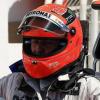Since last year I've found strange that everytime MS Ferrari was making a strong braking, after long straights, the acceleration bar was actioned in a very fast ratio.
I thought: what the hell MS was doing? Accelerating under heavy braking?
But the frequency was so fast, it couldn't be his foot doing that.
The trade of Rubens from Ferrari to Honda intrigued me even more.
How could Rubens face so much problems?
After all, brakes are similar for all teams.
Why was Honda's rear wheels locking under heavy braking zones?
There must be something extra in that Ferrari.
Then I concluded that it could only be an electronic device that syncronises the engine-brake system to aid/optimize the rear wheels under heavy braking, to achieve the full potential.
The stopping force of a F1 is the sum of two elements: brake disks and engine-brake.
The engine-brake is the inertial resistance force of the moving masses (pistons+cranksets+axels) and internal attrition inside the engine (pistons+block wall+joints).
Everybody that driver knows that when you lift the accelerator - without stepping in the clutch - makes the car to reduce it's speed.
There is a vectorial resistance that appears when the acceleration is not feeding the combustion chambers and power output is the minimal to allow the engine not to die.
As attrition is directly related to piston speeds, the higher the RPM drop, the higher engine-braking force
The brake disks are directly connected to the wheel axles and the attrition among pads and disks provide direct stopping force to the tires.
To achieve the full potential of the rear brakes the car/driver needs to modulate the trade off among both systems.
And also the trade off among the trail and heavy braking, to follow the ideal the attriction curve rate among the tires and track.
IMO, what the computer controlled braking device does is releasing an electronic instruction to the fly by wire accelerator and increase the engine RPM after every downshift, therefore, there would be a higher engine-brake force.
Usually, a driver just downshifts to use that effect.
Also, the computer syncronizes the sum of disk and engine brakes in order to optimize the braking and follow the ideal braking curve of tire and track attrition rate.
It would avoid the lock up of rear tires, providing stability in turn-in curves, conserving the tires and avoiding loss of time.
As I said, the frequency in the telemetry is so high that I don't believe it's MS doing it with his own foot.
If you look at this Hungaroring latest race, you will note the PDlR vs MS 2nd episode brodcasted with both cars acceleration/brake bar.
Even with MS on intermediate tires and PDlR with dry ones, MS was able to outbrake the McLaren.
How could it be possible without that gizmo?
Pedro was catching MS easily in the twist part bcs electronics doesn't help on lateral grip in the curves, but again if MS tires were inferior, Pedro should be overtaking MS at the end of the main straight.
Tallent alone is not the answer, IMO.
I know it's a bold and darring statement, and the explanation was not written good enough. Sorry
Other than that I have no explanation why the telemetry shown MS' car accelerating under heavy braking.
Let's have fun people.

































